Grace Cross’ new solo exhibition opens at SMITH
‘MOTHER IS A DRUM’ is inspired by childbirth and the quiet revelations of motherhood. The paintings are rich in symbolism – leaking breasts, spilt milk, and mashed food – and draw on familiar themes yet remain ambiguous. None of the objects Cross paints is insignificant, however strange or commonplace: each belongs within her cosmology of signs. Grace Cross spoke to ART AFRICA ahead of her third solo exhibition at SMITH in Cape Town, South Africa.
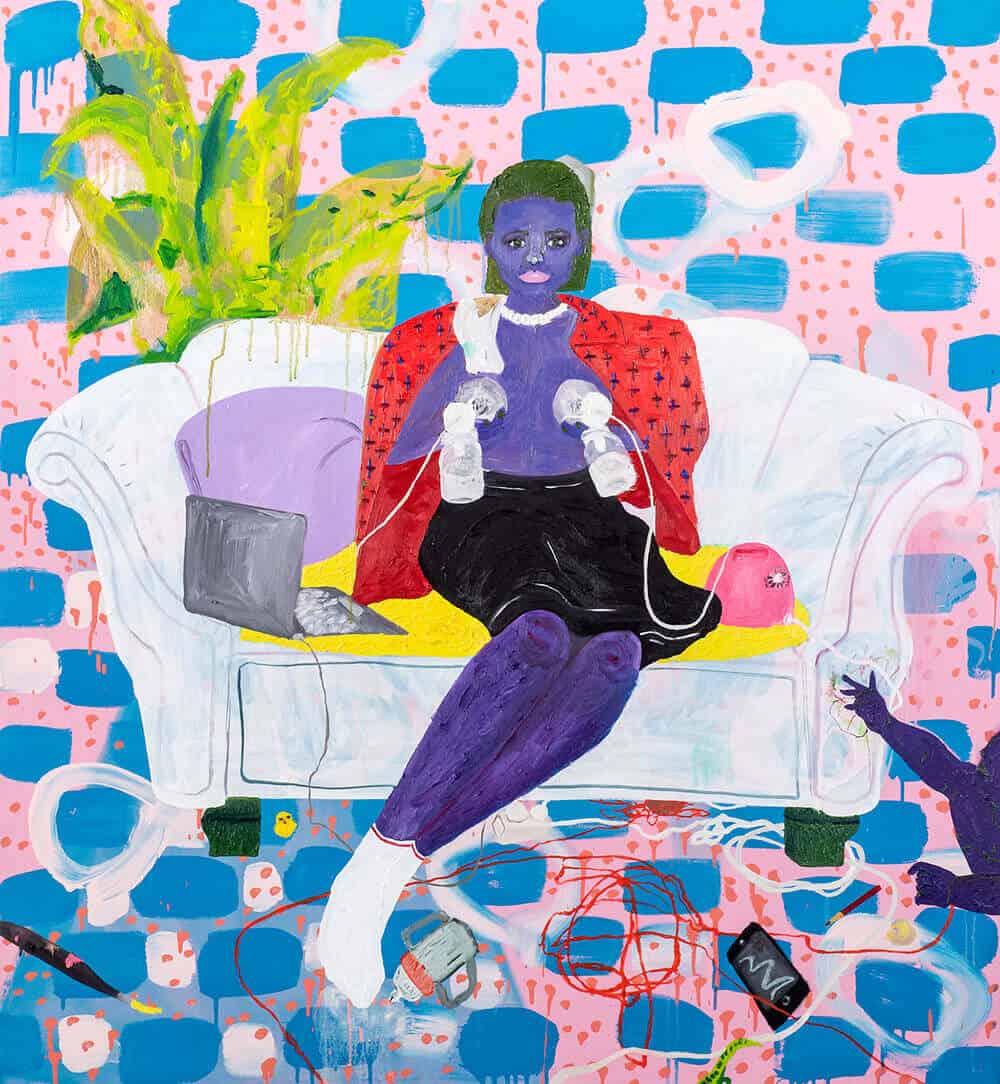 Grace Cross, The hand that rocks the cradle rules the world, 2019. Oil and acrylic on canvas, 120 x 112cm. All images courtesy of the artist & SMITH.
Grace Cross, The hand that rocks the cradle rules the world, 2019. Oil and acrylic on canvas, 120 x 112cm. All images courtesy of the artist & SMITH.
ART AFRICA: You are no stranger to representing your personal history in your work, and your latest series, MOTHER IS A DRUM, opening at SMITH focuses on the birth of your child. What was it like exploring your experience of motherhood through your artistic practice?
Grace Cross: It has been a very personal, scary, intense, yet rewarding experience using my journey to motherhood as the basis for my new show. It has been helpful for me to unpack my new role by painting my lived and felt experiences. Being and becoming a mother from pregnancy onwards is a mash of contradictions, full of love and pain, confidence and insecurity, need and rejection. I feel like motherhood is not something I have seen often explored in its complexity; maybe because of its normative (family) values or because of the patriarchal bent of the art world, or because it is very hard to both care for a baby and make work about that labor. Being a mother pushes you to be incredibly creative, to be the mother of invention, to pursue novel ways to coax, cajole and care for a new being who entirely relies on you for everything. My new role has shifted my studio practice, injected my art with a new level of care and need to articulate my feelings through it. In practical terms it has been a challenge to find the time, between nursing and playing with my baby, to get to the studio to make my ideas come to life. And psychically, it has challenged me to conjure new pockets of creative energy for myself, when the job of caretaking requires you give so much of yourself away. But it has been important to put my contradicting feelings into the work so that it speaks to many other people’s experience of the totally transformative, magic act of growing a child.
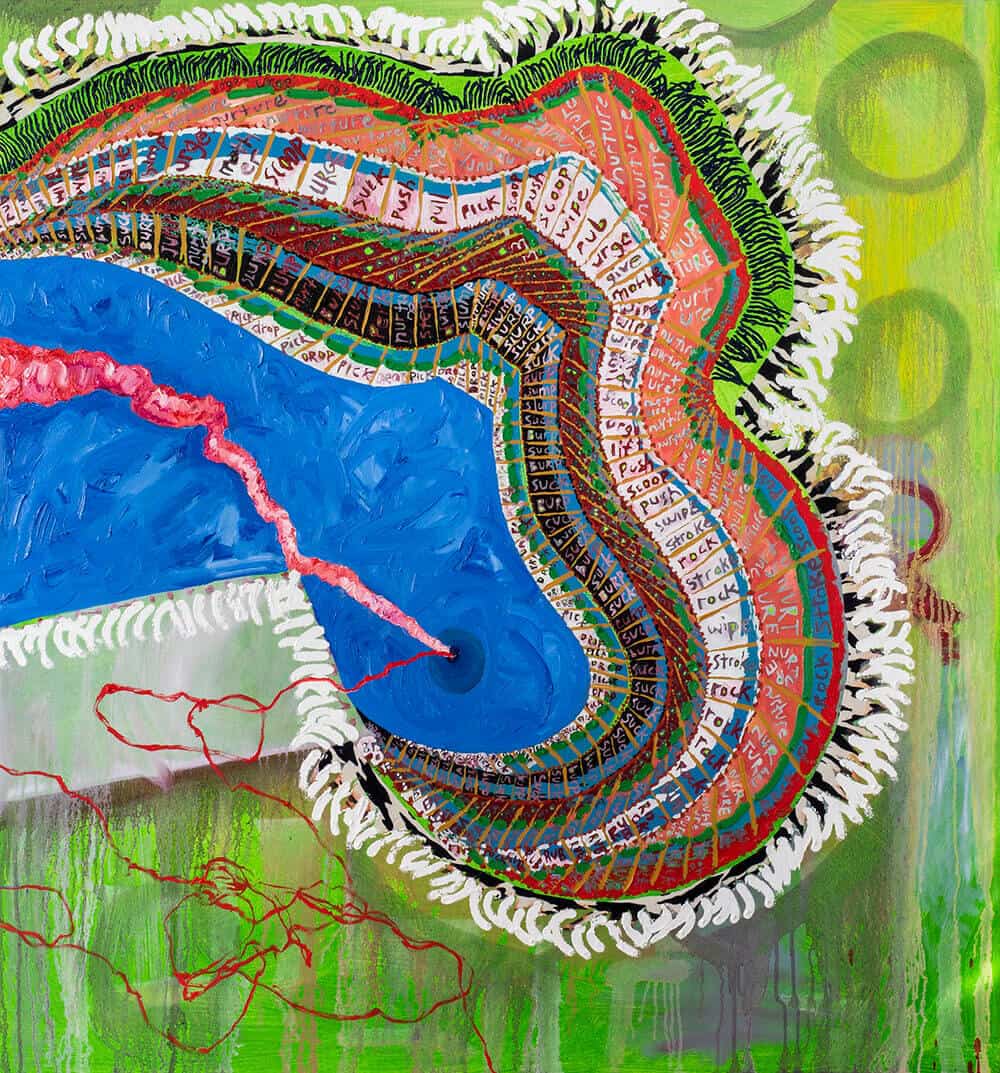 Comfort rug (when one becomes two), 2019. Appliqué material, oil and acrylic on canvas, 120 x 112cm.
Comfort rug (when one becomes two), 2019. Appliqué material, oil and acrylic on canvas, 120 x 112cm.
You have worked across a variety of mediums, from drawings to textiles. What drew you to painting as a medium for this series?
Painting, for me, is able to carry so many mediums and ways of working within its practice. I am able to be rough and loose, drawing impressions using oil bar on canvas. Or I can make my brushstrokes impersonate a weavings weft and warp; colour snaking its way over colour, drips hanging off the painted objects like the trim of a fabric. I want my paintings to be both painted textile and representational painting. Fringes are painted rather than appliquéd, because I am interested in the copy or facsimile as a performative recreation of the original or real fringe. The fringe is an important insight into how the fabric is woven together, and is also symbolically important to my practice; doing women’s work (material making and child-rearing) elevating the unseen labor and the histories of that labor.
A striking part of this series is your use of symbols – evil eyes, nipples, eggs, and rattles, among others – that appear to be imbued with meaning. What was your process in accumulating these visual symbols?
Many of the symbols are plucked from my daily life and the rituals of child-rearing, some are snippets into my heritage and others speak to a larger history. Each object is a metonym for something else – a story, a myth, an anecdote. I want each object I select to paint to be imbued with ritual power, a kind of sympathetic magic. The painted vessels link to my Greek heritage and the legacy of storytelling through painted vases, the eggs to fertility, life, and food, the yarn to the umbilical cord – each is selected to tell part of my story. They are neither static nor passive, these objects and their images, but alive in their associations and entanglements.
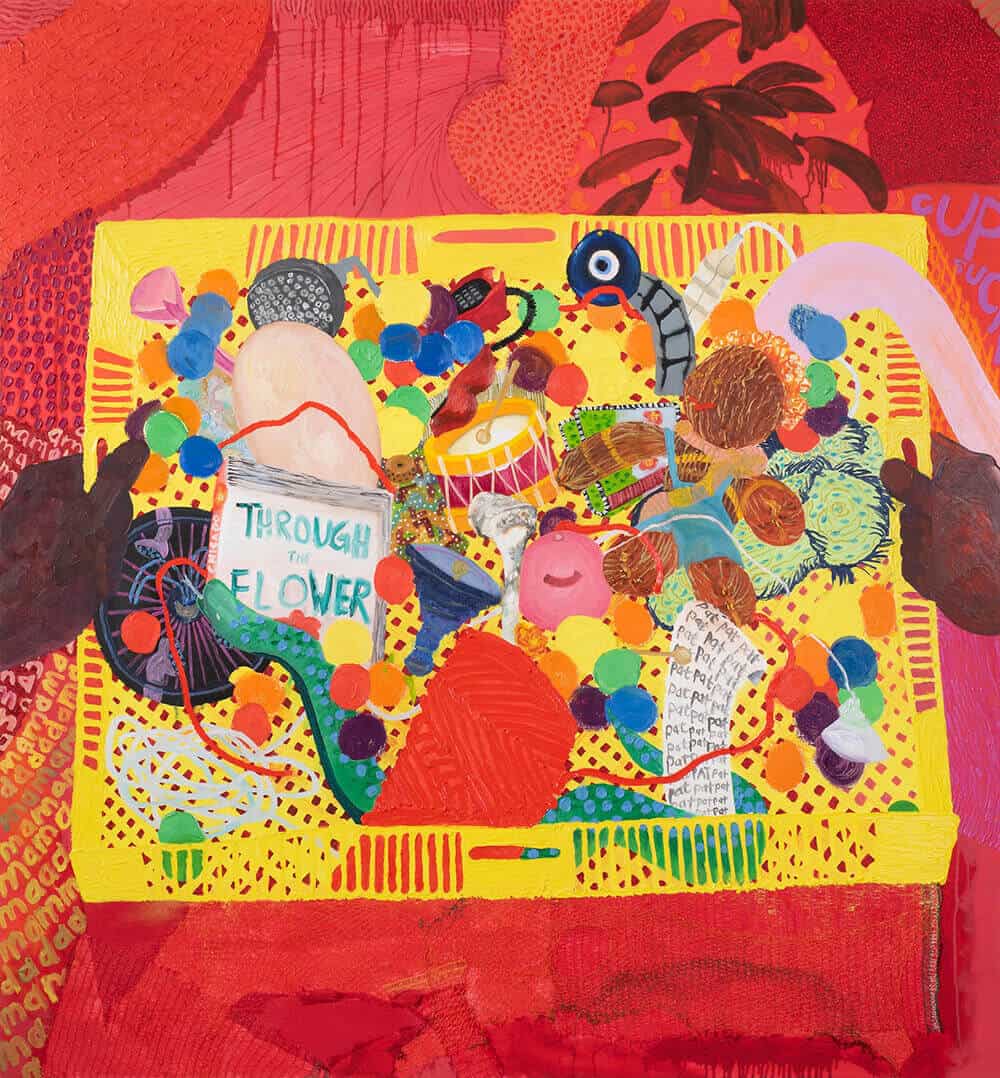 Her Playthings (the mother of invention), 2019. Appliqué material, oil and acrylic on canvas, 160 x 150cm.
Her Playthings (the mother of invention), 2019. Appliqué material, oil and acrylic on canvas, 160 x 150cm.
Your paintings are composed of lush, vivid colour palettes. What influenced these colour choices?
I love using bold primaries in my palette because they hit the viewer with intensity and noise that is hard to ignore. They activate space. I like that their boldness is also why they are seen in children’s classrooms and in their playthings, they are used to learn, to discipline, and to communicate. Reds are seen in all of the canvases as its colour is very important to me as a shade that is present in all of life from birth to death and of inside and out. It is the colour of passion and shame, love and rage, of warning and good fortune, of fire and fertility. And it is the colour analogous with the warm dark cave of the womb, to the sucked-raw areola, and to the pink inside of a baby’s mouth.
In addition to studying fine art, you also studied English language and literature at the University of Cape Town. Words are written into your paintings – I am I am I am in yellow, here here here in purple in another work. What does this use of text symbolize?
Text is very important to me, as a parallel practice to my painting. I am always writing about my practice, both in and outside the canvas. The words I paint are poetic musings on what the paintings are about. The repeated expressions of ‘ma ma ma ma’ or ‘pick drop pick drop pull’ are snippets heard, spoken, and acted out while mothering. It has been a wonder to witness my baby to learn the beginnings of language through sounds and repetition. Many of the written phrases in the paintings are words my baby has discovered or invented, and some texts are Zen incantations that speak to my practice of meditation in striving to be in the eternal present. Painting words is a way for me to cast spells in the pursuit of capturing an absolute presentness.
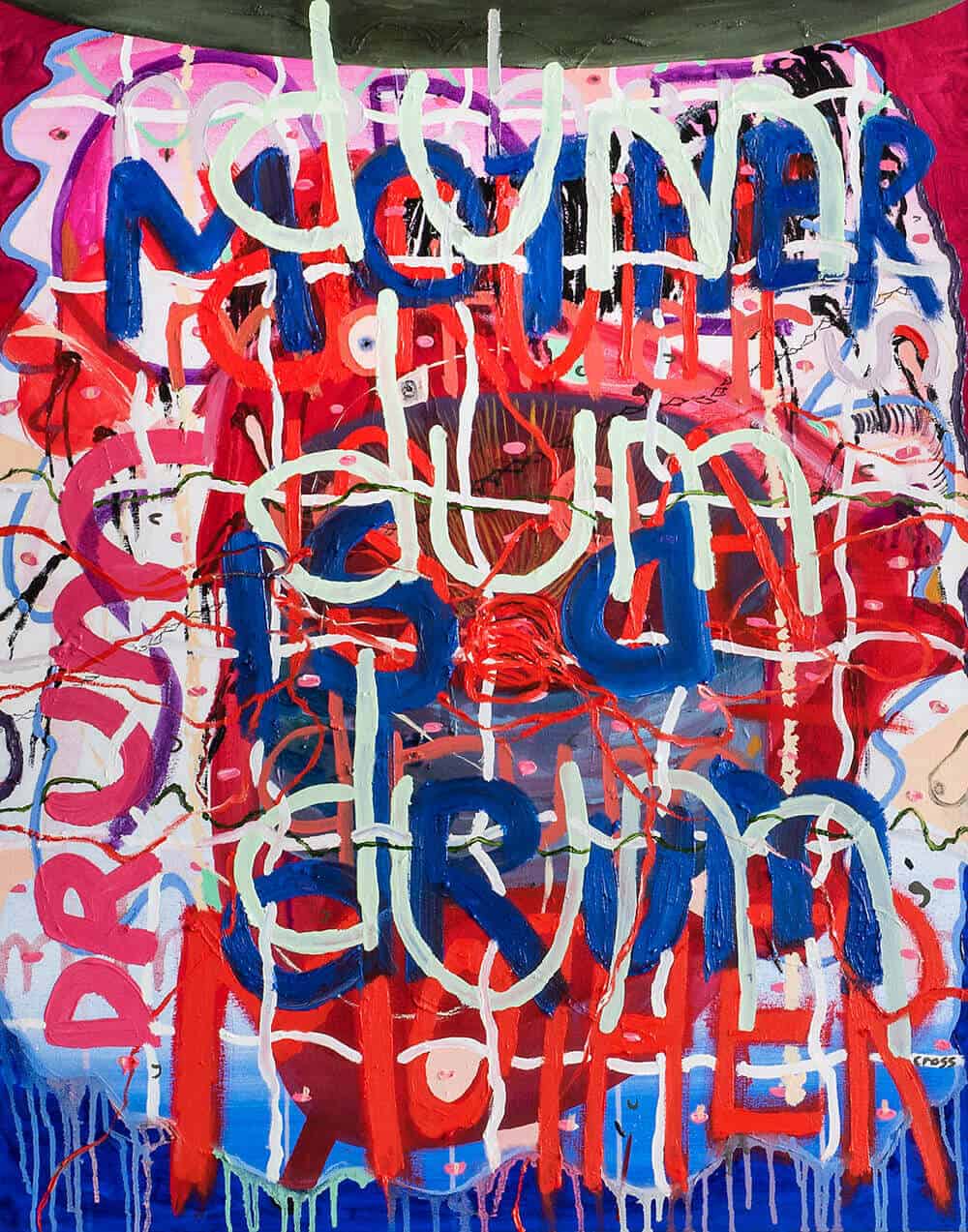 Mother is a drum, 2019. Oil on canvas, 85 x 67cm.
Mother is a drum, 2019. Oil on canvas, 85 x 67cm.
In both your use of symbols and words there is repetition across your body of work. What does this repetition represent to you?
So much of early motherhood is made up of various repeated actions. Urging, picking, dropping, scooping, wiping, rocking, changing, cleaning and handling a baby through its various milestones ad finitum. The repetition tries to convey the daily meditations of motherhood. Their importance, their everydayness, and the love involved in their manifestation. The show is about the labor of motherhood and the perpetual oneness and ever present-ness that the job requires. There is no stopping or breaks allowed. There is no separation between you and your child during pregnancy and then in their formative years, and that creates an ever-present and omnipotent nowness, and awareness of state that is both exhilarating and terrifying in its daily mundanity.
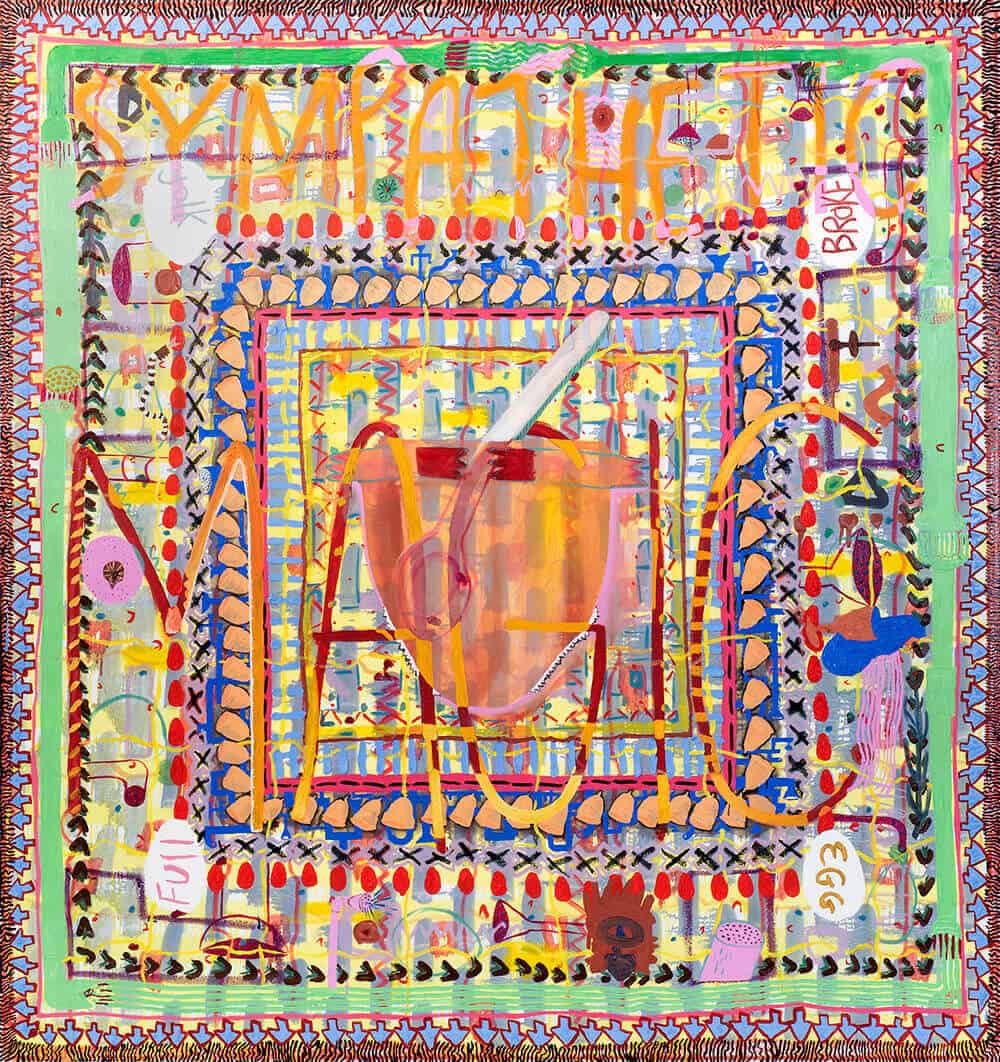 Sympathetic Magic (transitional blanket), 2019. Oil on canvas, 160 x 150cm.
Sympathetic Magic (transitional blanket), 2019. Oil on canvas, 160 x 150cm.
‘MOTHER IS A DRUM’ will be on view at SMITH, Cape Town, South Africa, from 31 July till 31 August. For further enquiries or to request a catalogue please get in touch at info@smithstudio.co.za
Zahra Abba Omar



